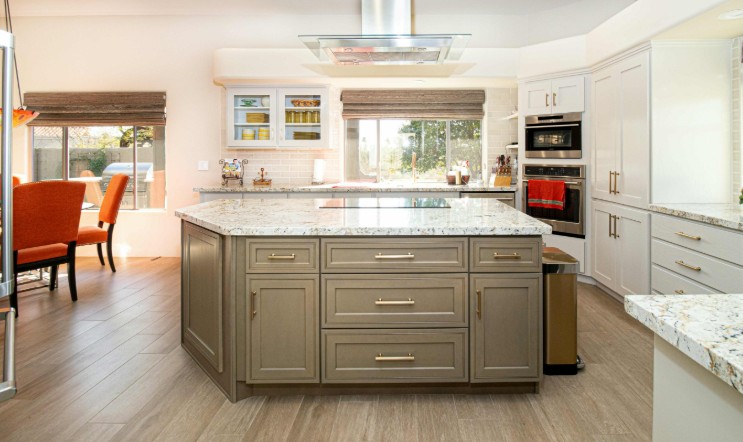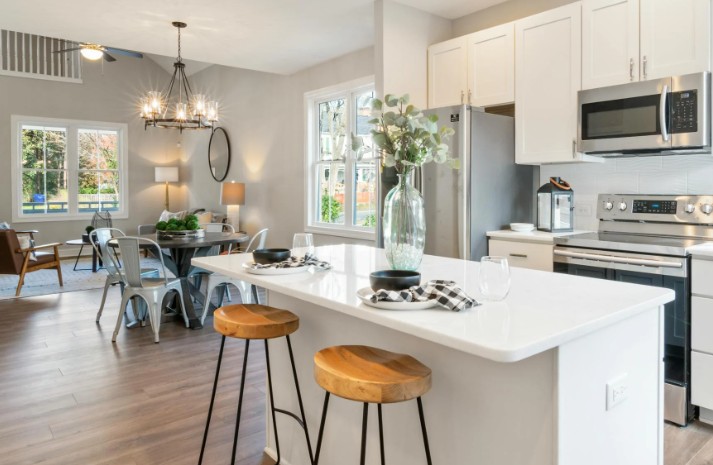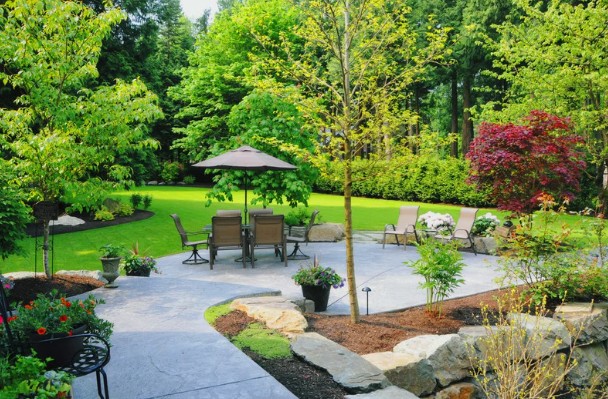Your kitchen is more than a place to cook. It’s where families gather, friends chat over coffee, and culinary experiments come to life. But creating a kitchen that’s both stunning and practical takes careful planning. You need a space that looks great in photos but also handles the chaos of daily meal prep without missing a beat.
Understanding the Basics: The Golden Triangle and Workflow
Before selecting finishes or fixtures, consider how you’ll actually use your kitchen. The concept of the “work triangle” has guided kitchen design for decades. This principle connects your three most-used areas: the sink, stove, and refrigerator. When these points form a triangle with sides between four and nine feet, you minimize unnecessary steps while cooking.
But the work triangle isn’t the only workflow consideration. Think about your cooking habits. Do you bake frequently? You’ll want ample counter space near your oven. Do multiple people cook at once? Plan for wider pathways and duplicate prep zones. A beautiful kitchen loses its appeal quickly when you’re constantly bumping into someone or walking across the room for a mixing bowl.
Material Selection: Balancing Durability, Cost, and Aesthetics
Kitchen materials need to withstand heat, moisture, stains, and constant use while still looking attractive. This is where smart choices make all the difference.
Countertops see the most action in any kitchen. Granite and quartz offer durability and elegance, though at different price points. Butcher block adds warmth but requires more maintenance. Laminate has come a long way in mimicking premium materials while staying budget-friendly. Consider how you cook: if you’re hard on surfaces, invest in something that can take the heat.

Flooring must handle spills, dropped items, and heavy foot traffic. Porcelain tile resists water and scratches beautifully. Luxury vinyl planks give you the wood look with easier upkeep. Hardwood brings timeless beauty but needs more care in a high-moisture environment.
Cabinetry defines your kitchen’s visual character while providing essential storage. Solid wood cabinets are an investment that can last decades. If you’re working with a tighter budget, high-quality plywood boxes with hardwood face frames offer similar longevity at lower cost. Many homeowners exploring kitchen cabinets offered in Salt Lake City find that custom or semi-custom options provide the best blend of quality and personalization.
Color and Lighting: Setting the Mood and Enhancing Functionality
Color choices dramatically affect how your kitchen feels. Lighter palettes make smaller kitchens feel more spacious and airy. Darker tones create drama and sophistication but can make a room feel closed in if not balanced with adequate lighting.
Don’t feel pressured to commit to an all-white kitchen just because it’s trendy. Two-tone cabinetry has gained popularity for good reason: darker lower cabinets ground the space while lighter upper cabinets keep things from feeling heavy. Colorful backsplashes or painted accent walls inject personality without overwhelming the space.
Lighting deserves as much attention as your color palette. Layer different types of lighting to create a functional and inviting space:
- Task lighting illuminates work areas. Under-cabinet LED strips eliminate shadows on your countertops while chopping vegetables or reading recipes.
- Ambient lighting provides overall illumination. Recessed ceiling lights or a central fixture ensure you’re not cooking in the dark.
- Accent lighting highlights architectural features or décor. Lights inside glass-front cabinets or above cabinets create visual interest and warmth.
Dimmer switches give you control over the mood, letting you shift from bright and energizing during meal prep to soft and intimate during dinner.
Appliance Integration: Seamlessly Blending Appliances with Design
Appliances take up significant visual and physical space in your kitchen. Modern design trends favor integrated appliances that blend into cabinetry rather than standing out as separate elements.
Panel-ready refrigerators and dishwashers accept custom cabinet fronts that match your cabinetry perfectly. While these cost more upfront, they create a streamlined, cohesive look that elevates the entire space. If that’s beyond your budget, stainless steel appliances in matching finishes still coordinate well without custom panels.
Think about appliance placement during your planning phase. A cooktop on your island creates a social cooking experience but may require additional ventilation considerations. Wall ovens eliminate bending but need sufficient cabinet height. An appliance garage keeps small appliances like toasters and mixers accessible but hidden when not in use.
Storage Solutions: Maximizing Space and Organization
Even the most beautiful kitchen becomes frustrating when you can’t find what you need or lack space for essentials. Smart storage solutions keep your kitchen organized without sacrificing style.
Deep drawers work better than shelves for pots, pans, and small appliances. You can see everything at a glance instead of digging through stacks. Pull-out shelves in base cabinets transform hard-to-reach corners into accessible storage. Vertical dividers keep baking sheets, cutting boards, and serving platters organized instead of precariously stacked.
Consider your upper cabinets carefully. Glass-front doors display beautiful dishware but require keeping contents organized. Open shelving creates an airy feel and puts everyday items within easy reach, though you’ll need to maintain a curated look. Traditional closed cabinets hide clutter but can feel heavy in smaller spaces.
Don’t overlook specialized storage for specific items. Spice pull-outs keep bottles organized and visible. Drawer dividers corral utensils. Tray dividers prevent the chaotic jumble of baking sheets. These small touches make daily cooking more pleasant.
Technology Integration: Smart Kitchen Features for Modern Living
Technology enhances kitchen functionality without compromising design when thoughtfully integrated. Smart faucets with touchless activation reduce germ spread and make tasks easier when your hands are full or messy. Smart lighting systems let you adjust brightness and color temperature with voice commands or apps.
Consider charging stations built into drawers or cabinets to keep devices powered without cluttering countertops with cords. USB outlets integrated into backsplashes or islands provide convenient charging spots that blend into the design.

Smart appliances offer convenience through features like remote preheating, recipe suggestions, and inventory tracking. A smart refrigerator might feel excessive for some, but a quality smart range with precise temperature control and recipe guidance could transform your cooking.
Balance is key with technology. Not every gadget adds value, and overly complicated systems can frustrate more than help. Choose technology that genuinely improves your kitchen experience rather than adding it for novelty’s sake.
Maintenance and Upkeep: Keeping Your Kitchen Beautiful and Functional
The most beautifully designed kitchen loses its appeal if it’s difficult to maintain. Factor in long-term upkeep when making design decisions.
Surfaces matter. Polished marble looks luxurious but stains easily and requires regular sealing. Honed or leathered finishes hide water spots and fingerprints better than glossy surfaces. Matte cabinet finishes resist showing smudges compared to high-gloss options.
Grout lines on tile backsplashes and floors need regular cleaning. Larger tiles mean fewer grout lines to maintain. Alternatively, glass or solid surface backsplashes eliminate grout entirely.
Cabinet hardware will be touched constantly. Choose quality pieces that won’t tarnish or loosen quickly. Oil-rubbed bronze and matte black finishes hide fingerprints better than polished chrome or brass.
Establish simple daily habits: wipe down surfaces after cooking, clean spills immediately, and put items away rather than letting clutter accumulate. These small efforts keep your kitchen looking fresh with minimal time investment.
Conclusion
Balancing beauty and function in kitchen design isn’t about choosing one over the other. It’s about making intentional decisions that serve both purposes. Start with workflow and storage needs, then layer in aesthetic choices that reflect your personal style.










